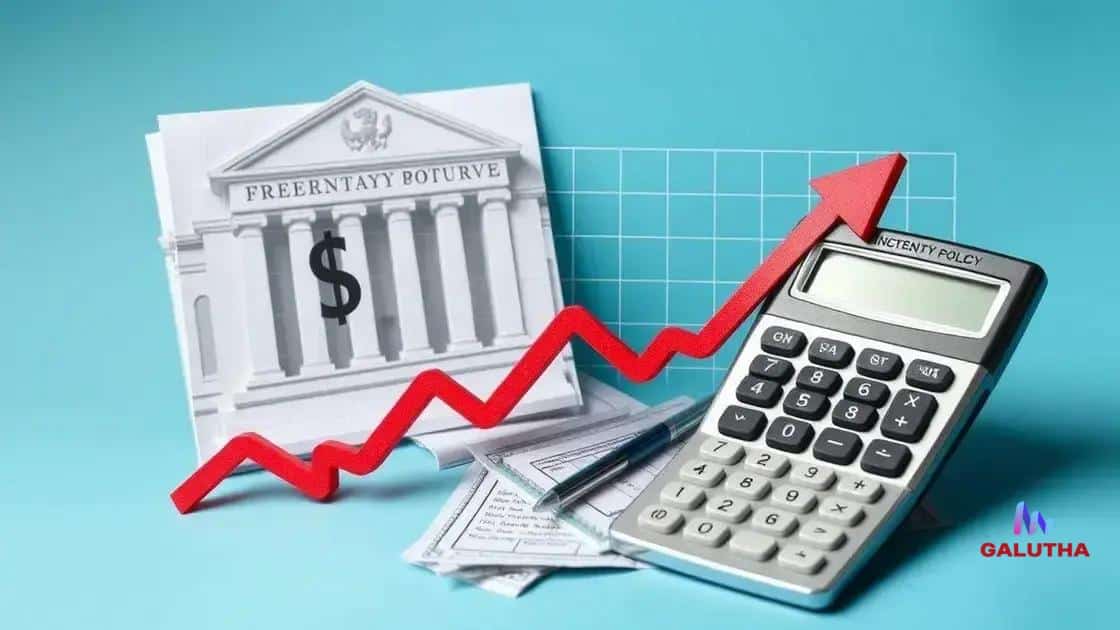Federal Reserve monetary policy updates: what you need to know
Federal Reserve monetary policy updates involve adjustments to interest rates and asset purchases, directly influencing inflation, consumer behavior, and business investment strategies in the economy.
Do you follow the Federal Reserve monetary policy updates? These updates play a crucial role in shaping the economy, influencing everything from interest rates to inflation. Let’s dive into what these changes mean for you.
Understanding the Federal Reserve’s role
To truly grasp the Federal Reserve’s role, it’s essential to understand its foundational purpose. The Federal Reserve, often referred to as the Fed, serves as the central bank of the United States, tasked with ensuring a stable financial system.
At its core, the Fed influences monetary policy to manage economic growth, keep inflation in check, and regulate the banking system. By adjusting interest rates, the Fed can either stimulate spending and investment or cool off an overheating economy.
Key Functions of the Federal Reserve
The Fed’s functions are varied and crucial for economic stability. Here are some of its primary roles:
- Conducting monetary policy: The Fed manages the nation’s money supply and interest rates.
- Supervising and regulating banks: Ensuring banks operate safely and soundly protects consumers.
- Maintaining financial system stability: The Fed monitors risks to the financial system to prevent economic crises.
- Providing financial services: The Fed serves as a bank for the U.S. government and other banks.
Understanding these functions helps clarify how the Fed affects your daily life. For instance, when the Fed changes interest rates, it influences loan rates for cars, homes, and credit cards, which in turn shapes consumer spending.
The Fed also conducts research on the economy. This research guides its decisions and helps predict future economic trends. By analyzing data on employment, inflation, and other indicators, the Fed can make informed adjustments to its policies.
Through these mechanisms, the Federal Reserve plays a vital role in not just mitigating the effects of economic downturns, but also in fostering conditions for sustainable growth.
Key recent monetary policy changes

In recent months, there have been significant monetary policy changes by the Federal Reserve that impact the economy. These adjustments are crucial for managing inflation and promoting stable economic growth.
One of the major changes has been the adjustment of interest rates. The Fed has raised rates to combat rising inflation, aiming to temper consumer spending and borrowing. This action helps cool down an overheating economy, allowing prices to stabilize.
Recent Rate Changes
Here are some key updates on interest rates:
- The Fed increased rates by 0.25% last quarter.
- Forecasts suggest more gradual increases are on the table.
- These changes aim to keep inflation around the 2% target.
- Market reactions show a mix of concern and optimism regarding growth.
Additionally, the Fed has made changes in its asset purchase strategies. Initially, during the pandemic, the Fed bought large amounts of government securities to inject liquidity into the economy. Now, it has begun to taper these purchases to reduce the balance sheet.
Another adjustment involves forward guidance. The Fed has communicated more clearly about future rate hikes, providing businesses and consumers with valuable information to make informed decisions. This approach helps avoid sudden shocks to the economy.
These recent changes in monetary policy are all part of the Fed’s broader strategy to maintain stability. The impact can be seen across various sectors, from housing to consumer goods, as interest rates influence loan costs and savings.
Impact on interest rates and inflation
The impact on interest rates and inflation is a critical aspect of the Federal Reserve’s monetary policy. When the Fed adjusts interest rates, it directly influences borrowing costs for consumers and businesses. This relationship plays a vital role in shaping economic activity.
Higher interest rates typically mean that loans become more expensive. As a result, consumers may reduce spending on big-ticket items like homes and cars. Businesses might delay expansions or investments due to increased borrowing costs. This slowdown in spending helps to control inflation, which is the rate at which prices rise.
How Interest Rates Affect Inflation
Understanding the link between interest rates and inflation is essential. Here are key points to consider:
- Increased rates dampen demand: Higher rates discourage borrowing, which lowers consumer demand and can lead to slower price increases.
- Reduced inflation pressure: When spending decreases, it puts less pressure on prices to rise, helping keep inflation in check.
- Timing is crucial: The Fed must carefully time interest rate changes to avoid triggering severe economic downturns.
- Expectations matter: If the public expects inflation to rise, they may change their behavior, which can cause prices to increase even if rates are raised.
As the Fed raises rates, inflation often stabilizes. Recent trends have shown a concerted effort to manage inflation through these adjustments. However, the Fed must strike a balance. Increasing rates too quickly can stall economic growth, while waiting too long might lead to unchecked inflation.
In summary, the interaction between interest rates and inflation plays a critical role in the overall economy. Monitoring this impact helps businesses and consumers make informed financial decisions.
Consequences for consumers and businesses

The consequences for consumers and businesses arising from the Federal Reserve’s monetary policy changes can be significant. When the Fed adjusts interest rates, it affects various aspects of the economy, impacting both individual consumers and businesses.
For consumers, higher interest rates often mean increased borrowing costs. This can discourage individuals from taking out loans for major purchases, such as homes or cars. When consumers borrow less, it can lead to a decrease in overall spending, which in turn affects businesses that rely on consumer demand.
Effects on Consumer Behavior
Some notable impacts on consumers include:
- Higher mortgage rates: Increased interest can make housing less affordable, leading to reduced home sales.
- Credit card interest increases: Consumers face higher costs if they carry debt, which may lead to less spending.
- Changes in saving habits: Consumers may choose to save more, waiting for better economic conditions before major purchases.
- Impact on personal finance: Individuals may need to reassess budgets and financial goals based on rising costs.
For businesses, the consequences are also pronounced. Higher borrowing costs can slow down business expansions and investment plans. Companies may be more cautious about taking on new debt when interest rates are high, which can lead to a slowdown in growth.
Business Reactions
As interest rates rise, many businesses respond with caution:
- Reduced investments: Companies may postpone or scale back projects that require financing.
- Job market impacts: Hiring may slow down as businesses adjust to the changing economic landscape.
- Pricing strategies: Businesses might increase prices to pass on higher costs to consumers, which can further affect demand.
Moreover, the heightened uncertainty can affect investor confidence, leading to volatility in financial markets. Both consumers and businesses must navigate these changes carefully as they adjust to the economic environment influenced by the Fed’s actions.
Future outlook for monetary policy
The future outlook for monetary policy is a topic of great interest for economists, investors, and consumers alike. As the Federal Reserve navigates the complexities of the economy, its decisions will continue to influence financial markets and everyday life.
Interest rates are a key aspect of this outlook. As the Fed evaluates economic indicators, it may decide to raise or lower rates based on inflation and growth forecasts. Currently, many experts believe that rates may stabilize in the coming months, which could provide some relief to consumers and businesses.
Economic Indicators to Watch
Several key economic indicators will shape the Fed’s decisions:
- Inflation rates: Persistent inflation may prompt more aggressive rate hikes.
- Unemployment levels: Lower unemployment might push the Fed to consider raising rates to prevent the economy from overheating.
- Consumer spending: Trends in consumer behavior can signal the health of the economy.
- Global economic conditions: Changes in the global market can impact U.S. monetary policy considerations.
As the Fed assesses these factors, it aims to balance economic growth with stability. If inflation decreases, the Fed may maintain current rates to support ongoing recovery. On the other hand, if inflation continues to rise, more rate hikes could be on the horizon.
Investor sentiment also plays a crucial role. As market participants react to Fed announcements, their expectations can affect stock prices and investment strategies. Clear communication from the Fed helps manage these expectations.
Looking ahead, the Fed will likely remain cautious, making data-driven decisions to foster economic stability while addressing inflationary pressures. The direction of monetary policy will be vital for shaping growth prospects and maintaining financial equilibrium.
FAQ – Frequently Asked Questions about Federal Reserve Monetary Policy
What is monetary policy?
Monetary policy refers to the actions taken by a central bank, like the Federal Reserve, to control the money supply and influence interest rates, aiming to achieve macroeconomic objectives.
How do interest rate changes affect consumers?
When the Federal Reserve raises interest rates, it typically makes borrowing more expensive for consumers, which can reduce spending on big purchases such as homes and cars.
What impact does monetary policy have on businesses?
Monetary policy can impact businesses by changing borrowing costs, affecting investment decisions, and influencing overall economic growth.
Why is understanding the Fed’s actions important?
Understanding the Federal Reserve’s actions is crucial for consumers and businesses to make informed financial decisions and to prepare for potential changes in the economy.





